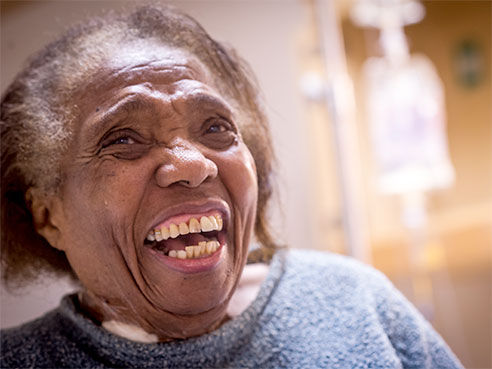 At age 88, Lena M. Smith was not surprised to be slowing down, but it did not mean the Birmingham resident had to accept it without investigating whether there was something more than age at play. She visited her doctor, Larry Hunt, M.D., in January at the University of Alabama at Birmingham to find out why her energy level had diminished.
At age 88, Lena M. Smith was not surprised to be slowing down, but it did not mean the Birmingham resident had to accept it without investigating whether there was something more than age at play. She visited her doctor, Larry Hunt, M.D., in January at the University of Alabama at Birmingham to find out why her energy level had diminished.
Hunt, a primary care physician and assistant professor in the UAB School of Medicine, detected a heart murmur, and an echocardiogram confirmed aortic stenosis. Smith needed her aortic valve replaced. UAB Heart and Vascular Services cardiothoracic surgeon Spencer Melby, M.D., and interventional cardiologist Seun Alli, M.D., scheduled Smith for the minimally invasive Edwards Lifesciences SAPIEN transcatheter heart valve replacement system surgery, and she became the 100th patient to undergo the procedure at UAB Hospital since the program began in August 2012.
How is she today?
“I feel great — amazing,” Smith said. “I’m a satisfied customer and ready to get moving again.”
| UAB is home to the state’s largest and oldest heart valve disease treatment program and is one of just a few in Alabama trained to offer the Edwards Lifesciences TAVR — the only transcatheter aortic valve replacement therapy approved for commercial use in the United States. |
UAB is home to the state’s largest and oldest heart valve disease treatment program and is one of just a few in Alabama trained to offer the Edwards Lifesciences TAVR — the only transcatheter aortic valve replacement therapy approved for commercial use in the United States. UAB performs more valve procedures annually than anyone in the state and has since the inception of its program.
UAB completed its 100th TAVR transplant in 18 months. Many programs around the country complete approximately 50 TAVR procedures in the same time period.
“We have had great success since we began doing the TAVR procedure, and a big reason for that is that we have a tremendous team in place,” Alli said. “In many cases, these are really sick people who don’t have a lot of other options. Open-heart surgeries just aren’t possible because of the age or other medical issues of the patient in most cases. But we’ve done 100 of these cases with minimum complications, and we’ve had very good outcomes. We’ve seen that when they come back to clinic for follow-up they are symptomatically better and have an improved quality of life.
“This is a revolutionary type of procedure, and we have the best-trained group to do it,” Melby said. “We’ve done the most in the state, and we have a good team approach. We work well together in helping our patients add life to their years, not just years to their lives.”
The big advantage to the TAVR procedure is that surgeons can replace valves without open-heart surgery, which is the gold standard of treatment for most patients. At Smith’s age, that was not the best option.
Smith’s daughter, Carolyn Hagerman, knew something had to be done to help her mom, who she says was always on the move.
That is how Hagerman and others knew something was not quite right with her mom prior to the procedure. Church members began telling Smith she seemed to be slowing down, which was odd to them. After all, Smith has exercised regularly for the past 48 years.
Smith also regularly cooked all day on Saturdays so she would have her meals ready for the entire week.
“She’s truly like the Energizer bunny,” Hagerman said. When her mom began having trouble with routine lifting of pots and pans, Hagerman told her it was time to talk to Hunt.
“I was losing my get-go,” Smith said. “My daughter told me to ask the doctor to give me something to speed me up because I was slowing down. Dr. Hunt said they were going to check on me to see what is causing my problems. I’m so glad they were able to figure it out so quickly.”
This event is not Smith’s first positive experience at UAB with a life-threatening issue. She was diagnosed with breast cancer in 1998 and beat it with the help of treatment from UAB.
“I’ve always said if something should happen where I die in this hospital, I will know and believe that everything that needed to be tried to save me will have been done,” Smith said.
As for Smith’s plans this time, they are the same as they were when she left UAB Hospital 15 years ago.
“I’m going to go back home, keep exercising and keep working as an usher at my church,” Smith said. “I’m going to enjoy life.”